Compared to traditional face-to-face training, online learning reduces costs while allowing employees to learn at their own pace. However, today’s office workers are already overwhelmed with information. Between emails, meetings, collaboration tools like Slack, and data-heavy platforms like Tableau, they process several gigabytes of data daily. To address this challenge, microlearning LMS platforms have emerged. These deliver bite-sized training that keeps employees engaged without adding to their digital fatigue.
Related: What is an LMS?
Microlearning is a modern approach to learning that focuses on delivering concise, focused, and easily digestible content.
In a modern business LMS like GoSkills, microlearning examples include interactive quizzes, skill tree progressions, spaced repetition, gamification, and micro-videos.
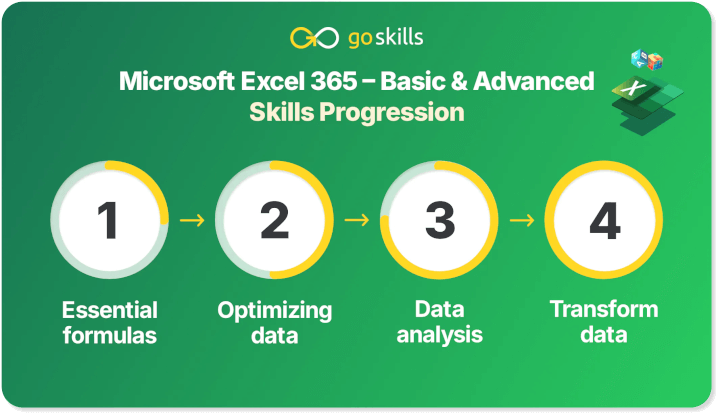
In all cases, the point is to break down complex concepts into bite-sized pieces.
9 Best microlearning platforms (with pros & cons)
| 1. GoSkills | 4. SC Training | 7. OttoLearn |
| 2. 5Mins.ai | 5. TalentCards | 8. eduMe |
| 3. Absorb LMS | 6. Axonify | 9. Docebo Learn |
Whether your learners are desk-based, frontline, or remote, the right Learning Management System (LMS) for microlearning can make all the difference. Below, we compare nine of the top microlearning platforms, breaking down their pros, cons, and ideal use cases — and yes, we start with GoSkills, a strong but often overlooked contender.
1. GoSkills
While many “best LMS” lists target platforms whose only product is the LMS software itself, GoSkills is both a microlearning LMS and a microlearning content provider.
Best for: Business skills training with a bite-sized approach. Ready-made and custom microlearning with 3-6 minute lessons.
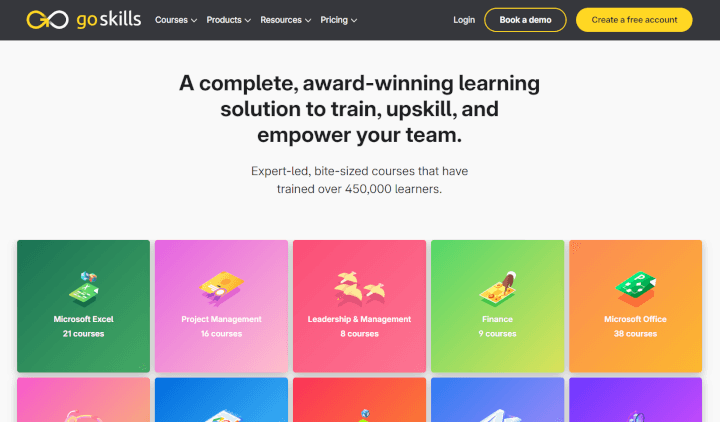
- Short, engaging lessons designed for busy professionals
- Wide range of business and professional skills courses
- Mobile-friendly learning experience
- Gamification (badges, streaks, progress tracking) to boost motivation
- SCORM-compliant and integrates with other LMSs via GoSkills Teams
- Built-in course authoring for custom content creation
- Supports uploading of microlearning elements such as embedded videos, interactive quizzes, and more
Cons
- Smaller library outside of business/professional topics
Experience the difference
Start transforming the way your organization learns — no credit card required. Get started in minutes!
Create your free account now2. 5Mins.ai
Dubbed the “TikTok of workplace learning,” 5Mins.ai offers short-form videos that keep learners engaged.
Best for: Highly engaging short-form video learning
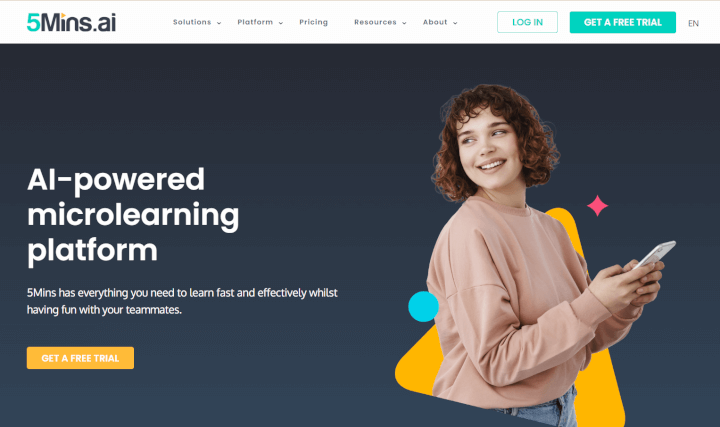
- Quick, visual, and addictive workplace learning
- Curated library of expert-created micro-videos
- Perfect for mobile, on-the-go consumption
Cons
- Limited in-depth course structuring for complex topics
- Mostly pre-curated content — less flexibility for custom learning paths
3. Absorb LMS
An enterprise-ready LMS with AI-powered authoring tools, Absorb LMS makes creating and delivering microlearning at scale seamless.
Best for: Scalable enterprise microlearning with AI tools
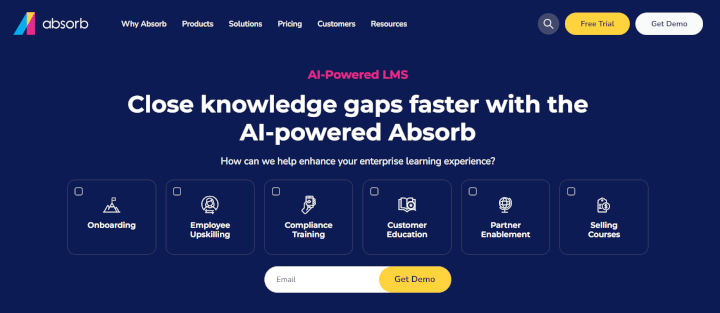
- AI-assisted content creation for rapid development
- Excellent analytics and reporting
- SCORM/xAPI compliance for flexible integration
- Strong mobile and offline learning capabilities
Cons
- Higher price point for smaller organizations
- More complex setup than lightweight platforms
4. SC Training (formerly EdApp)
A mobile-first platform that uses rich templates and gamification to power microlearning for frontline and deskless teams.
Best for: Frontline and deskless workforce training
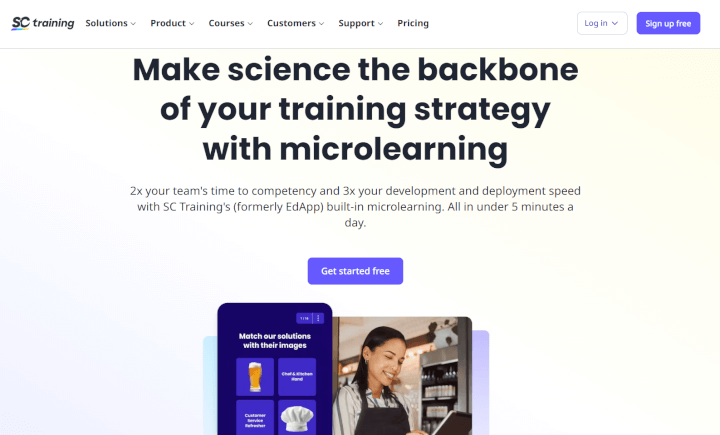
- Mobile-first with intuitive, template-based lesson creation
- Large template library for quick course rollout
- Gamification, leaderboards, and rewards
- Offline learning for remote teams
Cons
- Limited for advanced instructional design needs
- Best suited for microlearning, but less ideal for long-form training
5. TalentCards
TalentCards uses mobile-friendly flashcards, perfect for quick knowledge checks anytime, anywhere.
Best for: Flashcard-style microlearning
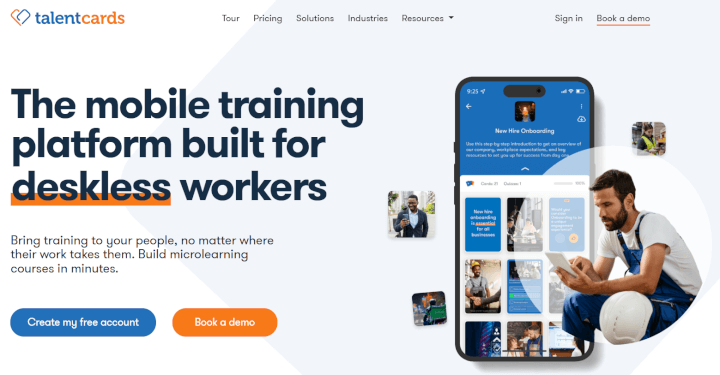
- Visual, card-based learning format
- Works well on mobile, even offline
- AI tools for fast content creation
- Quizzes and assessments for reinforcement
Cons
- Limited to card-based structure; less multimedia variety
- Better for quick knowledge checks than deep training programs
6. Axonify
Axonify uses gamified, personalized microlearning with spaced repetition to boost retention.
Best for: Habit-building and retention through gamification
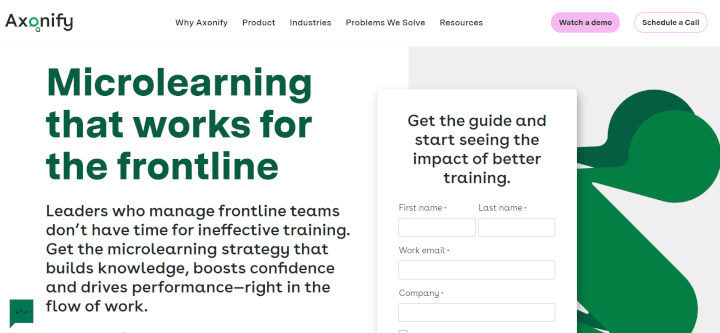
- Uses spaced repetition for long-term retention
- Gamified quizzes and rewards
- Personalized learning paths
- Strong track record in frontline training
Cons
- Industry focus on retail, service, and logistics
- Less suited for academic or highly technical programs
7. OttoLearn
Delivering “mastery moments” in just two minutes, OttoLearn focuses on micro-bursts and spaced repetition for lasting impact.
Best for: Ultra-short learning bursts with spaced repetition
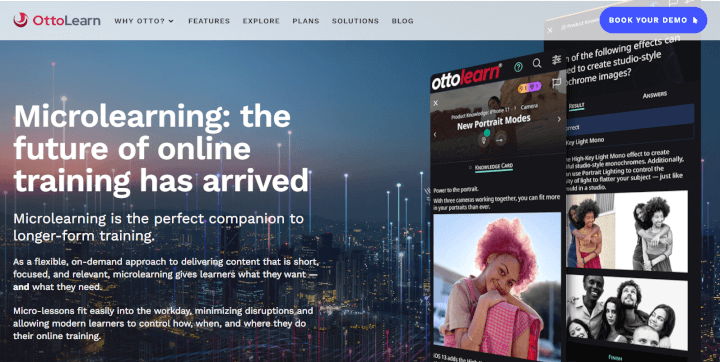
- 2-minute “mastery moments”
- Gamified, mobile-first delivery
- Multilingual content support
- Detailed analytics
Cons
- Narrow focus: best for reinforcement, not full courses
- Less robust for multimedia-heavy content
8. eduMe
eduMe integrates learning directly into daily workflows with role-based personalization and multimedia content support.
Best for: Embedding training into daily workflows
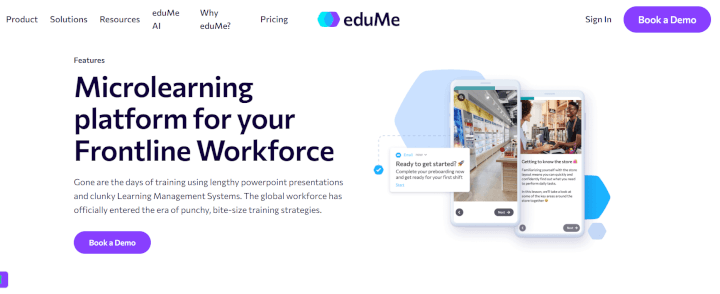
- Integrates directly with tools like Slack, Teams, and CRMs
- Role-based content personalization
- Quick authoring tools
- Supports video, text, and interactive formats
Cons
- Limited built-in library: primarily custom content
- Fewer advanced LMS features for formal programs
9. Docebo Learn
A robust enterprise LMS, Docebo uses AI to personalize learning experiences and deliver content at scale.
Best for: Enterprise learning with AI-powered personalization
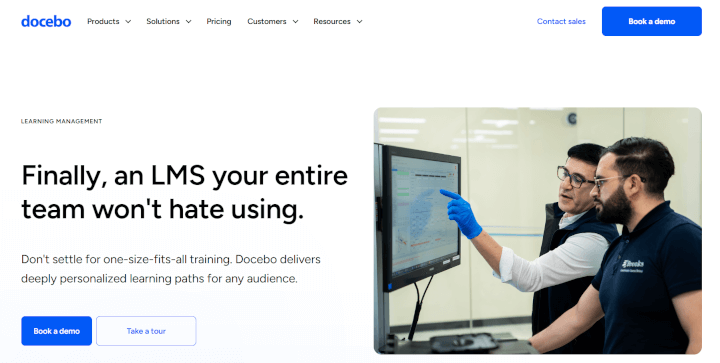
- AI features for content curation and personalization
- Wide integration ecosystem
- Suitable for large-scale deployments
- Advanced analytics
Cons
- Steeper admin learning curve
- Enterprise-level pricing
Understanding microlearning
What is microlearning? Microlearning is a modern approach to learning that focuses on delivering concise, focused, and easily digestible content. It's about breaking down complex concepts into bite-sized pieces. Microlearning is characterized by its brevity, accessibility, and adaptability.
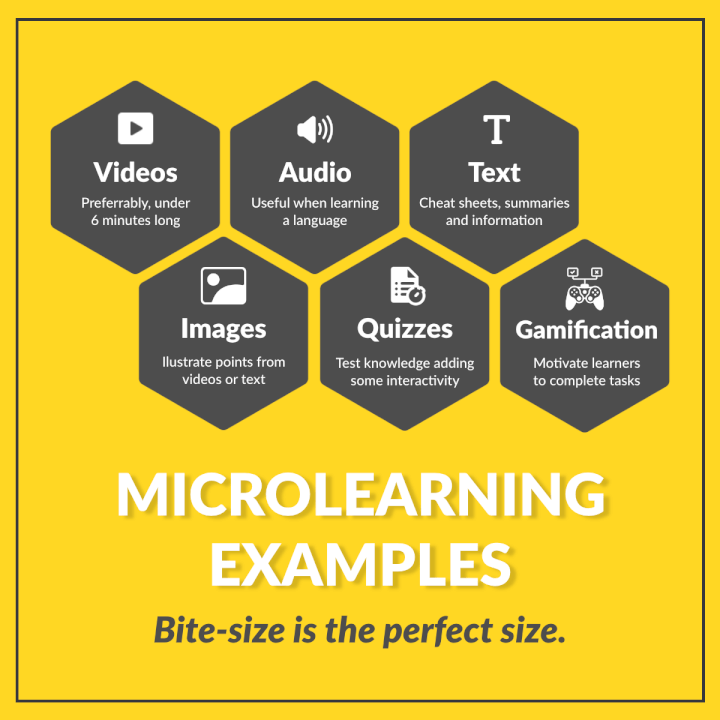
This learning approach isn't a trend without substance. Microlearning brings a plethora of advantages to the table. It enhances knowledge retention, saves time, and elevates engagement levels among learners. These benefits make it a powerful tool in the training arsenal.
Leveraging an LMS for microlearning
At the heart of the microlearning revolution lies the LMS. The best learning management systems are a central hub for creating, delivering, and managing microlearning content. They empower organizations to take full advantage of this revolutionary approach.
Key features of a microlearning LMS
An effective microlearning platform should offer certain key features. These include the following:
- Robust content delivery capabilities: Ensures efficient delivery of microlearning modules for seamless learner access.
- User-friendly interface: Simplifies navigation, encourages engagement, and facilitates easy micro-module access.
- Comprehensive analytics and reporting tools: Enables learner progress tracking, assessing microlearning effectiveness, and data-driven improvements.
- Mobile compatibility: Supports access on various devices for on-the-go microlearning.
- Integration with authoring tools: Seamlessly integrates with content management platforms, ensuring up-to-date and relevant microlearning content.
- Gamification and social learning integration: Enhances engagement with gamification and fosters social interaction within microlearning modules.
- Personalization options: Supports content customization to align with individual learner needs and preferences.
- Content management system: Organizes and manages microlearning content for learners and administrators to access.
- Security and compliance features: Ensuring data security and compliance with training regulations and standards, an SSL certificate is an essential protocol that keeps prying eyes away from data in transit
- Notification and reminders: Automates notifications and reminders, improving micro-module completion rates.
- User progress tracking: Monitors and tracks learner progress, aiding in identifying areas for improvement.
- Feedback and assessment tools: Provides instant feedback through quizzes and assessments, aiding comprehension assessment.
- Content version control: Ensures access to the latest microlearning content, preventing outdated information dissemination.
- Customizable reporting: Tailors reports to specific needs, extracting actionable insights from training data.
- Certification and credentialing: Supports issuing certificates or credentials upon micro-module completion for compliance and skill verification.
- Scalability: Accommodates growth by adding new microlearning content and users as needed.
- Multilingual support: Allows delivery of microlearning content in multiple languages to cater to diverse workforces.
Creating effective microlearning modules
Designing microlearning content
The success of microlearning hinges on how well content is designed. This involves identifying clear learning objectives, structuring content into bite-sized modules, and incorporating multimedia elements for better comprehension.
Learn more: The Ultimate Guide to Developing an Online Training Course
Adapting existing content for microlearning
Organizations often have a wealth of existing training material. Adapting these lengthy courses into micro-modules is crucial in embracing the microlearning approach. However, ensuring that content remains relevant and up-to-date is equally important.
Assessment and feedback mechanisms
Microlearning should not just deliver content but also assess the learner's understanding. Building quizzes and assessments into micro-modules and providing instant feedback are essential to effective microlearning.
8 Benefits of microlearning over traditional training methods
The distinction between microlearning and traditional training methods lies in the duration of the learning content and the underlying philosophies, strategies, and outcomes. Here are the key differences highlighting why microlearning is emerging as a transformative approach.
1. Duration and format
Traditional Training: Traditional training typically involves long, comprehensive courses or workshops that span hours or even days. These courses are often structured with set timelines and rigid schedules.
Microlearning: In stark contrast, microlearning condenses learning material into bite-sized, easily digestible modules. These modules are typically short bits of content that take around 3 to 5 minutes to assimilate on average. This approach allows flexibility regarding when and how employees engage with the content.
2. Learning focus
Traditional Training: Traditional methods often focus on delivering vast amounts of information in one go. This can overwhelm learners and result in lower retention rates.
Microlearning: Microlearning uses content chunking and emphasizes one specific learning objective or topic per module. This focused approach ensures that learners grasp and retain the core concepts, making it easier to apply knowledge immediately.
3. Engagement and interactivity
Traditional Training: Traditional training methods can sometimes be passive, with instructors delivering lectures and learners listening passively. Interaction and engagement may be limited.
Microlearning: The different microlearning examples leverage multimedia elements, gamification, and interactivity to engage learners actively. This approach encourages participation and enhances understanding through quizzes, scenarios, and real-life examples.
4. Accessibility and flexibility
Traditional Training: Traditional training often requires learners to be physically present at specific locations, making it less accessible for remote or geographically dispersed employees.
Microlearning: Microlearning modules foster mobile learning as they can be accessed from anywhere, anytime, using various mobile devices like smartphones or laptops. This flexibility accommodates modern work arrangements, including remote and mobile workforces.

5. Retention and application
Traditional Training: Extensive training sessions may lead to cognitive overload, resulting in limited knowledge retention and delayed application of skills learned.
Microlearning: Microlearning's concise nature aids in better retention, as learners focus on smaller, manageable pieces of information. This facilitates the quicker application of knowledge to real-world tasks. Microlearning has been demonstrated to boost retention rates by 25% to 60%.
6. Feedback and assessment
Traditional Training: In traditional training, assessments are often conducted at the end of a course or module, providing delayed feedback.
Microlearning: Microlearning incorporates frequent assessments and instant feedback. Learners receive immediate reinforcement or correction, aiding in understanding and knowledge reinforcement.
7. Adaptability and personalization
Traditional Training: Traditional methods have limited adaptability and personalization options, as course content is usually standardized.
Microlearning: Microlearning can be highly personalized, allowing learners to choose their learning paths and access content relevant to their specific needs, creating a more tailored learning experience.
8. Cost and resource efficiency
Traditional Training: Traditional training methods often involve substantial costs related to venue, materials, and instructor fees.
Microlearning: Microlearning can be a more cost-effective solution. It reduces the need for physical resources and minimizes employees' time from work duties.
Implementing microlearning strategies
Employee engagement and buy-in
The success of microlearning depends on the active participation of employees. Organizations must communicate the benefits of this approach and encourage self-directed learning to gain full employee buy-in.
Sequencing microlearning modules
Creating a logical sequence of microlearning modules is crucial to enhance learning retention. Learning pathways should be designed to guide employees through a progressive learning experience, with personalization options to cater to different learning styles.
Tracking and measuring success
To ensure the efficacy of microlearning, organizations must define key performance indicators (KPIs) and employ analytics tools to track and measure progress. Data analysis provides insights for continuous improvement.
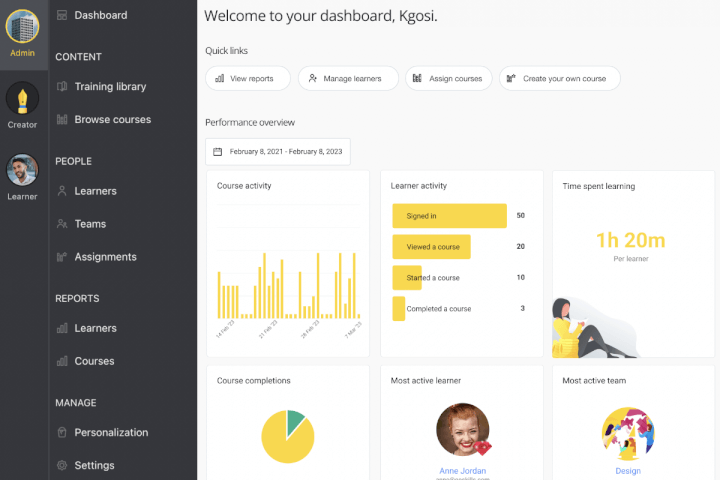
Embrace the microlearning revolution
The microlearning revolution, supported by LMS platforms, reshapes how organizations train their employees. It's a revolution founded on brevity, efficiency, and engagement.
As we recap the journey through this article, it's evident that microlearning isn't just a passing trend; it's a transformational approach to training. The enduring significance of LMS in employee training cannot be overstated, and organizations are encouraged to embrace this revolution fully.
In conclusion, let's embark on a journey to maximize LMS potential and harness the power of microlearning for bite-sized, impactful employee training. The future of training is here, and it's concise, engaging, and highly effective.
Experience the difference
Start transforming the way your organization learns — no credit card required. Get started in minutes!
Create your free account now



